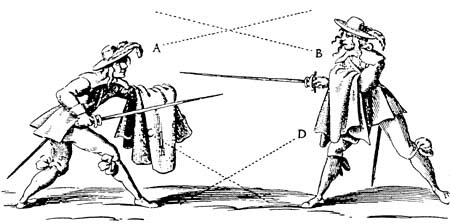Defend your honor, and your lady...
Learn about Eighteenth Century Fencing below:
It was not until the late seventeenth century that the right to wear the sword became the exclusive privilege of the
better classes. (Aylward, 3) Until this time all men no matter what their social standing had the right and the duty
to arm themselves
with the sword. Even members of the clergy were known to carry daggers and swords.
Thus, prior to this time, the most common types of swords in use were the long swords, claymores, and two hand swords.
Most of these swords featured straight, generally rigid blades, which were more for use in hacking and smashing types of
attacks. Once the sword became exclusive to the upper echelons, its use came under close observation of those deemed as
"maisters". These maisters took their cues from the Spanish and Italian schools of "fence" and sought to eliminate
cumbersome armor and heavy anti-armor swords in favor of much more streamline techniques.
The Sword had gone through numerous changes throughout the centuries, which revolutionized the art of sword
fighting. The masters endeavored to teach new methods which were much more efficient, to coincide with the
newer swords that were lighter, more flexible, and better formed (Hutton, 72), but especially to cater to
the rising middle class who had more leisure to learn the art, and the noblemen who distinguished themselves
by wearing the sword as an article of dress. (Martinez Academy) Fencing/sword fighting became an art
form in which the mastery of it depended more on the mind than on the strength of man. (Lover and Well Wisher, 8)
Hence, the art of defence was also known as the "science" of defence", in going along with the scientific mindset of
the century. For example, by using "mathematical proofs," Captain John Godfrey explained in his manual that he
sought to "weed the art of those superfluous, unmeaning practices" which masked the "true principles" of the
science of defense. (Godfrey, 2) Fencing was at first designed for defending, to preserve the life of
one self, rather than offending, to attack another. (Lover and Well Wisher, 6) The evolution of the
sword had also distinguished between the military and the civilian style of fighting.
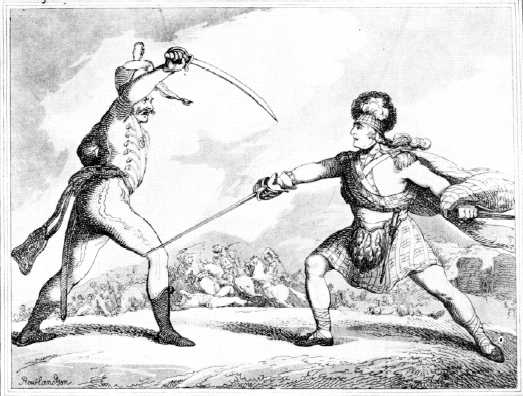
The two-hand sword was also known as the old English
“long sword.” It was a large sword with a broad blade with double edges. The best method to hold
the two-hand sword was to hold the sword in the left hand pointing upwards. Grasp it around the center, with the flat of
the blade resting against the shoulder. After the guard positions, one
could learn a combination of moves using the cuts (attacks), moulinets (sword
swung full circle), and the parries (defensive moves).

The rapier was a sword used only by civilians, as the word "rapier" suggests,
from the Spanish term espada ropera, meaning dress or costume sword. It was
a long double-edged weapon whose blade was much more slender than swords used
in battle and the cup-shaped hilt was usually elaborate. (Martinez Academy) The rapier usually had
"quillons" and "counterguards," which took the form of a
cup at the handle. It was often held in
the right hand with the forefinger crossed over the "quillon." Earlier, the edges were used, but later, the
deadlier point was more favored, and so the use of the edges was abandoned.
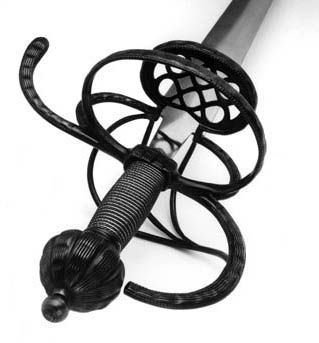
The Smallsword was a form of the rapier. Its blade was triangular and it was only useful
for the thrust, but the advantage of the smallsword was its lightness. The hilt was simple
and there was a light finger guard. (Martinez Academy)
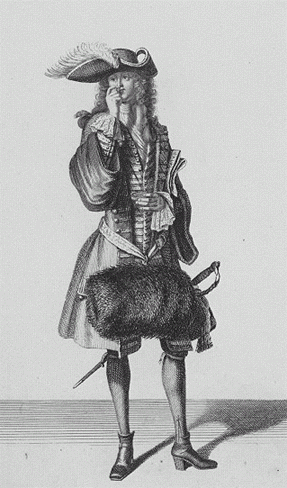
The Single-handed sword was a weapon with a simple cross hilt, consisting of a cross-guard,
grip, and large pommel, with a straight double-edged blade. Its blade had many forms,
but was generally wide, tapering to a sharp point. This weapon was used for the cut and thrust. (Martinez Academy)

The dagger was held in the left hand, with the point upwards, and the
thumb extended and resting in a cavity that was spoon-shaped in the forte of
the blade. The dagger “is used for parrying the thrusts of the sword,” and was
used sparingly in the attack itself. The dagger and sword combination eventually gave
way to using the rapier alone as it was thought to be faster and more offensive in nature.
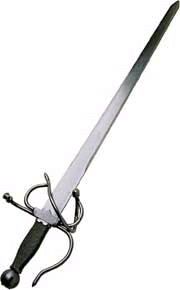
There were many techniques that could be combined using the rapier
and dagger, starting from a guard position, any number of the thrusts, feints,
and parries could be employed.
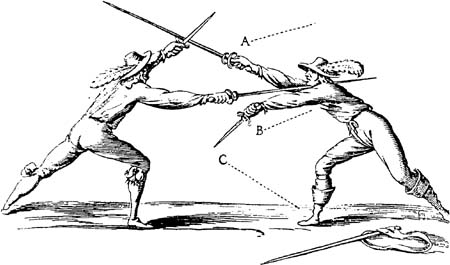
The broadsword was a
somewhat shorter sword compared to the rapiers and double edged sword. The edge
was utilized more with this sword while the point was rarely used for the
offensive manuevers. This sword was held like the rapier,
with the forefinger over the cross-guard.
The Sabre's blade was wide at the end near the guard and gradually became smaller toward the point.
It was a sword that was used for both cutting and thrusting. The sides of the blade contained fullers
(grooves), which extend from the heel of the blade to about the last third, where it became
flat and ended in a blunted point. The guard on the hilt entirely covered and protected the hand
from both cuts and thrusts. There were two types of sabres which are very different from each other:
the military sabre, which was used in battle, and the dueling sabre for fencing. (Martinez Academy)
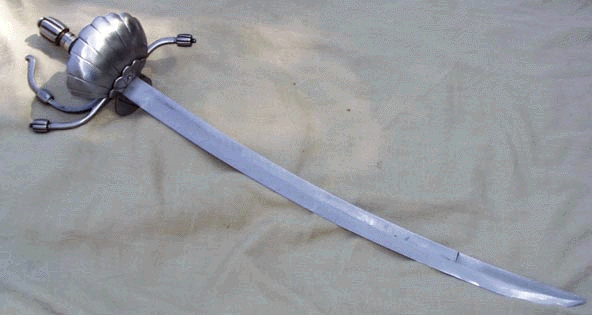
The Buckler was
a small round shield. At its largest it
was approximately fourteen inches in diameter.
The buckler was held in the left fist
and it did not rest on the arm, for a shield resting on the arm was called a
target. Sometimes a buckler would have a
spike used for stabbing at close contact.
Using the designated guards, there were many combinations of attacking cuts
and defensive parries which would have been used.

The Cloak was also known as the cape. It was a sleeveless garment that could be either
long or short and worn over the shoulders. Although it was commonly an article of dress,
it was used as a defensive weapon by wrapping the cloak over the left arm and using it as
a shield to avert the attacking blade. It was also used offensively in many ways - by
throwing it over the adversary's blade to stop the sword, throwing it over the adversary's
head to blind him, or whipping it at the adversary's face to momentarily sting and distract
him. (Martinez Academy)
